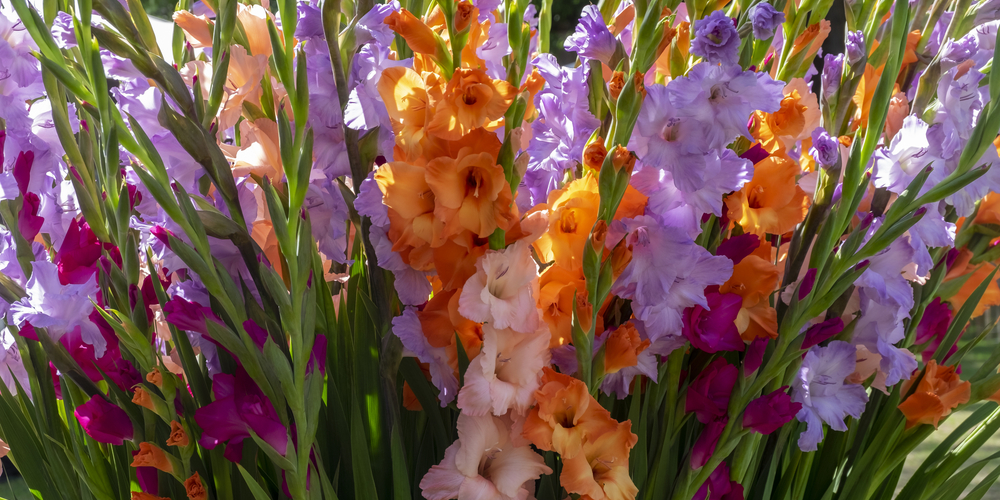Gladioli are stunning tropical-looking plants that can brighten any garden, no matter where you place them. Regardless of your preferences, you’ll for sure find one that suits your taste. Indeed, there are around 10,000 varieties of this plant. The characteristic upright spikes can be yellow, orange, red, pink, purple, or white. You can even find species with variegated blooms for an even more dramatic effect.
Despite their delicate looks, they are relatively easy to grow. Plus, they adapt to most climate conditions. Gladiolus flowers last longer than most other plants, making them an ideal choice for improving the aesthetics of your yard. They can grow in acidic or alkaline soil, so there is no need for amending your ground.

Plus, they adapt to most conditions, provided that the drainage is good. Remember to pick a location that isn’t constantly damp: excessive moisture can cause your plants to rot. Once established, they require little to no maintenance. You can leave hardy bulbs on the ground and get flowers year after year.
These plants grow from bulb-like structures underground. To get the most out of these flowers, you should plant their bulbs in May and locate them in a sunny spot in your yard. It is best to plant these flowers in the spring.
Depending on your climate conditions, you’ll be able to enjoy most varieties’ blooms between 60 to 100 days after planting. Dig them in October to remove the dead bulbs.
But should you soak gladiolus bulbs before planting? If you have this doubt, don’t worry: many gardeners are unsure about this question. But if you want to find an answer, you’ve landed in the right place.
Should You Soak Gladiolus Bulbs Before Planting?
The answer to this question is straightforward. You can soak gladiolus bulbs before planting to get rapid germination from these plants. Do so in plain tap water to not saturate your bulbs with nutrients.
This step is crucial if you live in a warm region or have pests and diseases in your garden. Besides soaking your bulbs in tap water one day before planting, you can also place them in a solution of carbaryl for about 15 minutes before you place them on the ground.
The only insects you should keep an eye out for when planting gladiolus in your garden are thrips. These insects can cause your plants to stop blooming and eventually die. Luckily, you can prevent their attacks. Dust your bulbs with the chemical carbaryl after purchasing. You can do so by shaking them in a bag with less than half a teaspoon of the product for every twelve bulbs. Doing so will help you kill thrips and prevent them from ruining your plants.
Also, throw away unhealthy-looking bulbs before planting. Doing so eliminates the need to treat bulbs. Don’t forget to space your gladiolus. If you got more than one plant, leave six inches apart between the bulbs.
Add some bone meal or organic fertilizer to boost your plants’ growth. Gladiolus thrive in high phosphorus environments, especially when they need to establish in a new location. A bone meal is one of the best sources of this nutrient for your gladioli.
Before covering your bulbs, add a light layer of carbaryl: it works as effective pest control and allows you not to worry about anything else after planting your gladioli. Of course, you should always keep an eye for weeds and remove them as soon as you notice them. If you live in a rainy area, avoid overwatering your plants.
Some dryness won’t harm your bulbs. On the contrary: it will encourage their roots to go deeper to look for moisture, which means your flowers will be hardier!
Should You Soak Gladiolus Bulbs Before Planting: The Bottom Line
Gladiolus are easy-to-care plants that produce colorful flowers that make your garden more appealing, especially during the blooming season. While they don’t require much attention from your side, they will do better if you meet their basic requirements.
To reiterate, if you are in a hurry to get your bulbs into germination, soak them one night before planting them outdoors. Don’t forget to put into practice our recommendations! Water your plants if you live in a warm area, but avoid overdoing it if you want healthy plants.
Related Article: Can Bulbs Survive in USDA Hardiness Zone 9?
